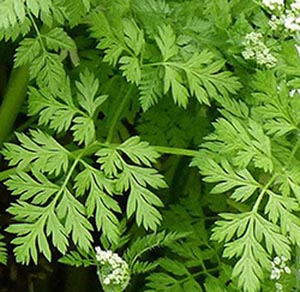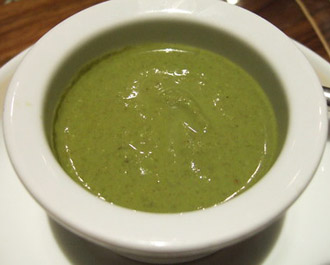Chervil Nutrition facts
Garden Chervil is one of the fine herbs that play a pivotal role in the Mediterranean, especially French cuisine. Its myrrh-scented, flavorful leaves, and stems compose several important chemicals having medicinal value.
Chervil is a parsley family herb, which perhaps originated in the mountainous Southern Russia and Caucasus regions and spread across Anatolia and Europe through the Romans.Binomially, chervil is a common plant genus of the family Apiaceae.
Scientific name: Anthriscus cerefolium. Some of the common names are Garden Chervil, French Parsley, Sweet Cicely, etc.
 |
| Chervil-flat leaf variety. Note for light-green, smooth, broad, parsley-like leaves. |
Chervil is a small, annual herb growing to a height of 15 inches. Its anise-scented lacy, fern-like, light green leaves resemble that of carrot tops. The plant prefers fertile, well-drained soil to flourish. During the early summer, its white bloom appears in tiny umbels as in dill.
Chervil is classified into four main varieties:
Garden Chervil- plain or curly.
Root chervil (Chaerophyllum bulbosum)- Cultivated for its tapering, parsnip-like root, which is used as a vegetable.
Wild chervil or cow parsley (Anthriscus sylvestris), and
Bur chervil
Garden Chervil is the most common type grown in home gardens and backyards. Its leaves possess subtle, slightly aniseed-like flavor.
Health benefits of Chervil
Fresh chervil, like parsley, is one of the low calorific herbs. Nonetheless, its leaves and stems feature exceedingly high amounts of antioxidants, vitamins, minerals, and dietary fiber.
Chervil, being a close member of the parsley family of herbs, contains similar health-benefiting essential volatile oils like methyl-eugenol (1-allyl-2,4-dimethoxybenzene).
Eugenol has antiseptic actions. It has therapeutic applications in dentistry as a local anesthetic and antiseptic agent for teeth and gum diseases. Eugenol has also been found to reduce blood sugar levels in diabetics; however, further detailed studies are required to establish its role.
Cervil is the of the herb along with parsley, tarragon that is rich in polyphenolic flavonoid antioxidants, including apigenin. Research studies suggest that apigenin works as a neuroprotector and may prevent Alzheimer's disease patients by limiting neuronal damage in their brains. It has also been found to have cancer-protective functions as well.
Dried herb is one of the finest sources of minerals like potassium, (4740 mg/100 g) calcium, zinc, manganese, iron, and magnesium. Potassium is an essential electrolyte inside cells and body fluids that helps regulate heart rate and blood pressure by countering the pressing effects of sodium. Iron is essential for the production of heme, which is a critical oxygen-carrying component inside the red blood cells. Manganese is used by the body as a co-factor for the antioxidant enzyme, superoxide dismutase.
Furthermore, the herb is also rich in many antioxidant vitamins, including vitamin-A, vitamin-C, vitamin-E, and phenolic antioxidants like zeaxanthin, lutein, and cryptoxanthin.
Fresh garden chervil holds many essential vitamins such as riboflavin (vitamin B-2), niacin (vitamin B-3), pyridoxine (vitamin B-6) and thiamin (vitamin B-1). These vitamins play a vital role in carbohydrate, fat, and protein metabolism by acting as co-enzymes inside the human body.
Dried leaves of this herb compose:
69% of folates,83% of vitamin C,
195% of vitamin A,
71% of Pyridoxine 134% of calcium,
399% of iron and
80% zinc.
(Note: the values are in % of RDA per 100 g (RDA-Recommended daily allowance))
| Principle | Nutrient Value | Percent of RDA |
|---|---|---|
| Energy | 237 Kcal | 12% |
| Carbohydrates | 49.10 g | 38% |
| Protein | 23.20 g | 41% |
| Total Fat | 3.90 g | 19% |
| Cholesterol | 0 mg | 0% |
| Dietary Fiber | 42.8 g | 107% |
| Vitamins | ||
| Folates | 274 µg | 69% |
| Niacin | 5.4 mg | 34% |
| Pyridoxine | 0.930 mg | 71% |
| Riboflavin | 0.680 mg | 52% |
| Thiamin | 0.380 mg | 32% |
| Vitamin A | 5850 IU | 195% |
| Vitamin C | 50 mg | 83% |
| Electrolytes | ||
| Sodium | 83 mg | 6% |
| Potassium | 4740 mg | 100% |
| Minerals | ||
| Calcium | 1346 mg | 134% |
| Copper | 0.440 mg | 49% |
| Iron | 31.95 mg | 399% |
| Magnesium | 130 mg | 32.5% |
| Manganese | 2.100 mg | 91% |
| Zinc | 8.80 mg | 80% |
Selection and storage
Fresh chervil can be available year-round in the farmer markets. Dried leaves can easily be found in the spice section in packets, air-sealed bottles, etc., and sometimes as a "fines herbes" mixture. If you are growing them in your backyard, their leaves are ready for harvesting within about six to eight weeks after sowing the seeds. Gather its leaves before the plant begins showing flowers.
In the farmer markets, buy fine, light-green, fresh leaves and firm stems. Avoid wilted, spots, and sunken yellow leaves.
Use fresh leaves in the cooking. If you are growing any in your backyard, gather its fresh leaves as needed. Chervil is very fragile but stores well kept in the refrigerator wrapped in a damp paper towel. The dried herb can be stored well for a few months when kept in a sealed glass container and placed in a cool, dark, and dry place.
Preparation and serving methods
Fresh leaves and tender stems can be used in cooking. Wash in cold water and dry mop using a soft towel. Finely chop using a paring knife. Its leaves lose flavor on prolonged cooking, so it should be added at the end of cooking or sprinkled on salads, dishes as parsley, and leaf-cilantro.
Here are some serving tips:
 |
| Mediterranean Green sauce-salsa verde. Photo courtesy: toyohara |
Chervil's subtle, slightly aniseed tinge enhances the flavor of dishes.
The herb is widely used as a garnish. Many dishes are served with fresh green chopped chervil, and parsley sprinkled on top.
Chervil along with parsley, tarragon, and thyme is one of the items in traditional green sauce, sauce verte.
Chimmichurri is an Argentinian green sauce made from finely chopped chervil, parsley, minced garlic, tarragon, spring onions, olive oil, and vinegar. Its leaves have been used in the preparation of vegetable, chicken, fish, and meat dishes.
It is one of the common ingredients in the famous Mediterranean green sauce, salsa verde, a cold sauce made of parsley, capers, garlic, onion, anchovies, olive oil, and vinegar.
Freshly chopped parsley is an excellent addition to the green salad.
Freshy and dry parsley leaves can be used in the preparation of chutney, dips, pesto, etc.
Medicinal uses
Chervil's essential oil chemicals are found to have antiseptic and anti-fungal applications.
In many traditional medicines, chervil herb parts are found used as an expectorant, stimulant, and diuretic (excess urine output) and may help relieve digestion and high blood pressure symptoms. (Medical disclaimer).
Safety profile
Do not collect chervil (Anthriscus sylvestris) from the wild as it features similar plant morphology to poison hemlock, or fool's parsley (Aethusa cynapium) and water dropwort.
Chervil oil may cause dermatitis in some sensitive individuals. (Medical disclaimer).
≻≻-Back to Herbs from chervil. Visit here for an impressive list of all varieties of herbs with complete illustrations of their nutrition facts and health benefits.
≻≻-Back to Home page.
Further Resources:
Refer Stanford School of Medicine Cancer information Page-Nutrition to Reduce Cancer Risk (Opens in New Window).